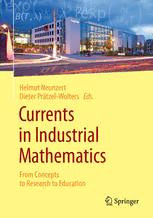
Currents in Industrial Mathematics: From Concepts to Research to Education PDF
Preview Currents in Industrial Mathematics: From Concepts to Research to Education
Helmut Neunzert Dieter Prätzel-Wolters Eds. Currents in Industrial Mathematics From Concepts to Research to Education Currents in Industrial Mathematics Helmut Neunzert (cid:2) Dieter Prätzel-Wolters Editors Currents in Industrial Mathematics From Concepts to Research to Education Translated from German by William Uber Editors HelmutNeunzert DieterPrätzel-Wolters FraunhoferInstituteforIndustrial FraunhoferInstituteforIndustrial MathematicsITWM MathematicsITWM Kaiserslautern,Germany Kaiserslautern,Germany TranslationoftheGermanEdition:MathematikimFraunhofer-Institut.Problemgetrieben–Modell- bezogen–Lösungsorientiert,publishedbySpringer-VerlagGmbH2014,©2015.Allrightsreserved. ISBN978-3-662-48257-5 ISBN978-3-662-48258-2(eBook) DOI10.1007/978-3-662-48258-2 LibraryofCongressControlNumber:2015953325 Mathematics Subject Classification (2010): 00-02, 00A07, 00A35, 00A69, 01A74, 00A71, 34-XX, 35-XX, 60Gxx,62-07,93-XX,76-XX,91Gxx,97-XX SpringerHeidelbergNewYorkDordrechtLondon ©Springer-VerlagBerlinHeidelberg2015 Thisworkissubjecttocopyright.AllrightsarereservedbythePublisher,whetherthewholeorpartofthemate- rialisconcerned,specificallytherightsoftranslation,reprinting,reuseofillustrations,recitation,broadcasting, reproductiononmicrofilmsorinanyotherphysicalway,andtransmissionorinformationstorageandretrieval, electronicadaptation,computersoftware,orbysimilarordissimilarmethodologynowknownorhereafterde- veloped. Theuseofgeneraldescriptivenames,registerednames,trademarks,servicemarks,etc.inthispublicationdoes notimply,evenintheabsenceofaspecificstatement,thatsuchnamesareexemptfromtherelevantprotective lawsandregulationsandthereforefreeforgeneraluse. Thepublisher,theauthorsandtheeditorsaresafetoassumethattheadviceandinformationinthisbookare believedtobetrueandaccurateatthedateofpublication.Neitherthepublishernortheauthorsortheeditors giveawarranty,expressorimplied,withrespecttothematerialcontainedhereinorforanyerrorsoromissions thatmayhavebeenmade. Editorial:AnnikaDenkertandClemensHeine Translator: WilliamUber Coverphoto:G.Ermel,FraunhoferITWM Printedonacid-freepaper SpringerispartofSpringerScience+BusinessMedia(www.springer.com) Foreword The employees of a mathematical Fraunhofer Institute spend a great deal of their time discussingproblemswithindustrialclientsandthensolvingtheseproblemswiththehelp of mathematics and computers. The periods of reflection occasionally made possible by publicprojectsandself-financedpreliminaryresearcharenormallyusedtobuildthemath- ematical foundation necessary for finding our clients’ solutions. Taking a step back to critically examine one’s own activities and then to precisely and understandably articu- late them requires great inspiration and an enormous commitment of time. Nonetheless, 18employeesand5othermathematicianscloselyconnectedtotheInstitutehaveventured toreportontheirthoughtsandactionsinthisbook. Our point of entry is represented by the four basic concepts that determine our work: modeling, computing, optimizing and analyzing data. What these terms mean to us is describedinfourrelativelyshortconceptchapters. Next,fiveprojects—perhapsbetterreferredtoasprojectgroups—arepresentedasex- amples;andhere,wetakethisbusinessofpresentingveryseriously.First,wedescribethe non-mathematicalproblemandexplainthedeficienciesinthestandardapproachesforits solution.Wealsoexplainwhytheexistingmathematicsisofteninadequateanddescribe how many preliminary works surrounding question clarification have already emerged from the Institute for Industrial Mathematics ITWM, in the form of doctoral theses, for example. The core of these five research chapters, however, is solid mathematics—the models and their numerical evaluation. Finally, we describe the “solution,” that is, what thecustomergetsfromus,whichoftenincludessoftware. In a closing chapter, we describe in detail how this problem-driven, model-based, solution-oriented mathematics can be integrated into mathematics instruction in our schools, in order to emphasize its significance and to promote students’ joy in learning mathematics. Inwritingthisbook,wehavekeptquitediversegroupsofreadersinmind:First,there arethepeopleinindustryandbusiness,towhomwewishtomakeclearthatmathemati- ciansdon’tjustdiscussor analyzeproblems,theyalsosolvethem.Second,therearethe universitymathematicians,whomwewanttoconvincethatthisapproachcanalsoprovide v vi Foreword newimpulsestomathematics.Third,thereareuniversitystudents,whowanttoknow,and withgoodreason,whattheywillreallybedoinglaterintheirprofessionallives—foronly asmallnumberofthemwilllectureatuniversities.Andfinally,therearethosewhowant tobecometeachersorwhoalreadyare;thisgroupcanreadhowmathematicsinstruction intheclassroomcanberevitalized. IsamathematicalFraunhoferInstitutereallyentitledtoclaimthatitcanfulfillallthese promises? There are more than65 institutes in theFraunhofer-Gesellschaft,and three of themarebasedonmathematicalmethods:TheITWMinKaiserslautern,theSCAI(Insti- tute for Algorithms and Scientific Computing) in Sankt Augustin, and MEVIS (Institute for Medical Image Computing) in Bremen. Among these, the ITWM today enjoys the highest industrial revenues and the most rapid growth. The Institute’s fantastic growth over the nearly 20 years of its existence is shining evidence that mathematics really has become a key technology. For this reason, we believe that we can indeed turn all of our readersintofansofourkindofmathematics! Kaiserslautern,Germany June2015 DieterPrätzel-Wolters HelmutNeunzert Contents PartI Introduction Problems Trump Methods: A Somewhat Different Mathematics fromaSomewhatDifferentInstitute . . . . . . . . . . . . . . . . . . . . 3 DieterPrätzel-WoltersandHelmutNeunzert PartII Concepts Modeling . . . . . . . . . . . . . . . . . . . . . . . . . . . . . . . . . . . . . . 33 HelmutNeunzert Numerics . . . . . . . . . . . . . . . . . . . . . . . . . . . . . . . . . . . . . . 49 OlegIliev,KonradSteiner,andOliverWirjadi DataAnalysis . . . . . . . . . . . . . . . . . . . . . . . . . . . . . . . . . . . . 65 PatrickLangandJürgenFranke OptimizationProcessesinPractice . . . . . . . . . . . . . . . . . . . . . . . . 83 Karl-HeinzKüfer PartIII Research VirtualProductionofFilamentsandFleeces . . . . . . . . . . . . . . . . . . 103 RaimundWegener,NicoleMarheineke,andDietmarHietel ModelingandSimulationofFiltrationProcesses . . . . . . . . . . . . . . . . 163 OlegIliev,RalfKirsch,ZahraLakdawala,StefanRief,andKonradSteiner MaximalMaterialYieldinGemstoneCutting . . . . . . . . . . . . . . . . . . 229 Karl-HeinzKüfer,VolkerMaag,andJanSchwientek RobustStateEstimationofComplexSystems . . . . . . . . . . . . . . . . . . 291 JanHauth,PatrickLang,andAndreasWirsen vii viii Contents OptionPricinginPractice—Heston’sStochasticVolatilityModel . . . . . . . 351 SaschaDesmettre,RalfKorn,andTilmanSayer PartIV Education AppliedSchoolMathematics—MadeinKaiserslautern . . . . . . . . . . . . 403 WolfgangBockandMartinBracke Part I Introduction Problems Trump Methods: A Somewhat Different Mathematics from a Somewhat Different Institute DieterPrätzel-WoltersandHelmutNeunzert Thisbookisdedicatedtomathematics-basedtopicsthataredrivenbypracticalproblems whose solutions generate innovation. The formulations of these problems have arisen in the context of projects carried out at the Fraunhofer Institute for Industrial Mathematics (ITWM), and the majority of the authors of this book are either employed at the Fraun- hofer ITWM or are closely affiliated with it. Fraunhofer Institutes dedicate their work to problemsin industry; a mathematicalFraunhoferInstitute therefore makes “Industrial Mathematics”. Thebook’seditorsoriginallysuggested“FraunhoferMathematics”asatitle.Thissug- gestionwasdiscarded,however,sinceitfoundnoconsensusamongtheauthors.Abook about“FraunhoferMathematics”mighthavealsohadapolarizingeffect.Formanymath- ematicians,itwouldhavealsobeenaprovocativetitle,onethatgeneratesconfusionabout whatexactly“FraunhoferMathematics”refersto. Mathematics is the science with the highest degree of abstraction; there is virtually one hundred percent agreement about what is recognized as mathematics; and mathe- matical results are highly objective, intrinsically verifiable, and formulated in a largely standardized language. Mathematics is divided into the categories of pure and applied, although making even this basic distinction is somewhat difficult. It also happens occa- sionally that the works of important mathematicians become identified with their origi- nators, so that one then speaks, for example, of Hilbertian or Riemannian mathematics. There are also schools that have developed particular structural edifices of mathematical thoughtandwhoseworksarethencited,forexample,asBourbakiorconstructivistmath- ematics. D.Prätzel-Wolters·H.Neunzert(B) FraunhoferInstitutfürTechno-undWirtschaftsmathematikITWM,Kaiserslautern,Germany e-mail:[email protected] ©Springer-VerlagBerlinHeidelberg2015 3 H.Neunzert,D.Prätzel-Wolters(eds.),CurrentsinIndustrialMathematics, DOI10.1007/978-3-662-48258-2_1
